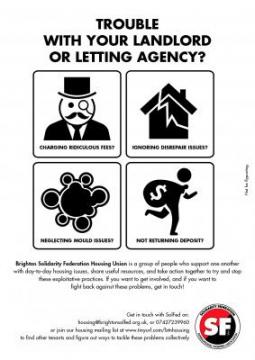Damp and Mould
In summary:
- You should be able to dry your clothes inside without this creating damp and mould problems
- Your house or flat should be able to deal with moisture - e.g. by having extractor fans and facilities for drying your clothes
- Your landlord or agency can’t just tell you to ‘open your windows’ more regularly
- If your landlord or agency won’t do anything about the problem, you can report them to the council, who can make them take action
What’s the problem?
The most recent council figures claim a third of houses in Brighton are dangerously damp. We suspect this to be a conservative estimate. Money-hungry landlords and agents might dismiss these problems, but the effects on our health are serious. Inhaling or touching mould spores can cause an allergic reaction. It can also cause asthma attacks. Mould is a particular problem for babies and children, elderly people, people with skin conditions such as eczema, respiratory conditions such as asthma, and those with a weakened immune system.
What can we do?
As many of us have experienced, reporting problems with damp and mould to your letting agent or landlord does not always mean that they are dealt with. Damp and mould is a health and safety issue, meaning that it is governed by the Housing Health and Safety Rating System (HHSRS). Crucially, the government’s guidance for enforcing the HHSRS states that:
The dwelling should be able to cope with normal occupant moisture producing activities without persistently high relative humidities. There should be provision for the safe removal of moisture-laden air during peak production. This should include extraction during cooking or bathing, either by mechanical means, or passive stack ventilation and direct venting of clothes drying facilities (whether tumble driers or drying cabinets) to the exterior.
As well as that:
There should be sufficient and appropriate means of ventilation to deal with moisture generated by normal domestic activities without the need to open windows.
What this means is that if you report damp and/or mould to your landlord or letting agency, they cannot simply tell you to dry your clothes outside and/or to open your windows. This is because very often damp and mould is because of structural problems with the property, which the landlord is responsible for. If the problem with drying clothes is caused by moisture build-up, this could be solvable through the provision of a dehumidifier.
If you’re having problems with damp and mould, you may find the following template letter useful (click me!)
The Council
If there is damp or mould in your house or flat that is affecting your physical or mental health, the council have the power to intervene in the problem. The government’s Housing health and safety rating system: guidance for landlords and property-related professionals states that something can be classified as a ‘hazard’ if it compromises ‘The basic physical and mental needs for human life and comfort’. As a result of the council’s intervention, your landlord may be obligated to do something about it.
When you contact the council, they should send an Environmental Health Officer to inspect the problem.
They will use a piece of legislation called the Housing Health and Safety Rating System to determine the severity of the problem. The Environmental Health Officer will either classify the damp and mould as a category 1 problem, meaning that the landlord is legally obliged to take action, or as a category 2 problem, meaning that the landlord may be obliged by the council to take action.
The council’s target for responding to inquiries is three working days.
Below are two template letters to initiate contact with the council concerning a severe damp and mould problem. This should follow a letter or email to the landlord (similar to the above template) which informs them of these problems. If they don’t respond appropriately to this, then communicating with the council is vital. A notice from the council to the landlord requiring them to make repairs concerning conditions dangerous to health will prevent a revenge eviction.
There are letter templates here, in recognition of the fact that the council will not reply quickly or promptly. To that end, they hold the council to their own targets regarding responses to these sorts of inquiries.
1. Damp and mould: letter to council 1
2. Damp and mould: letter to council 2
If you still don’t get a response with the date of an inspection, you should speak to the council’s complaints team. Brighton and Hove Council’s complaints website is here: https://www.brighton-hove.gov.uk/content/council-and-democracy/feedback-....
After the inspection, read the report carefully, and seek further advice and support on how to respond. You could attend one of the SolFed drop-ins, which occur on the final Sunday of each month, from 2.15pm-3.30pm at the Phoenix Centre (BN2 9ND) in Brighton. We don’t expect the council to do anything without a fight. If they were going to, they would have done so by now. Fighting these battles on our own can be isolating, stressful, time-consuming, and makes it easy for the council to dismiss us. We think that supporting one another to demand better living conditions for everyone gives us collective strength. The council might be able to ignore one of us, but they can’t ignore ten of us.
 07427239960
07427239960


